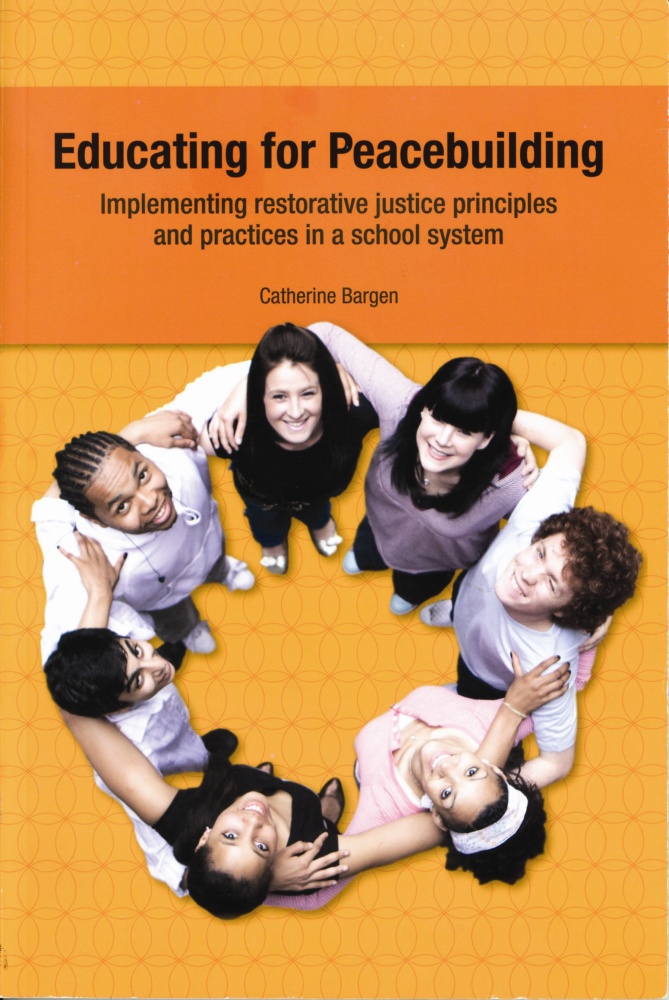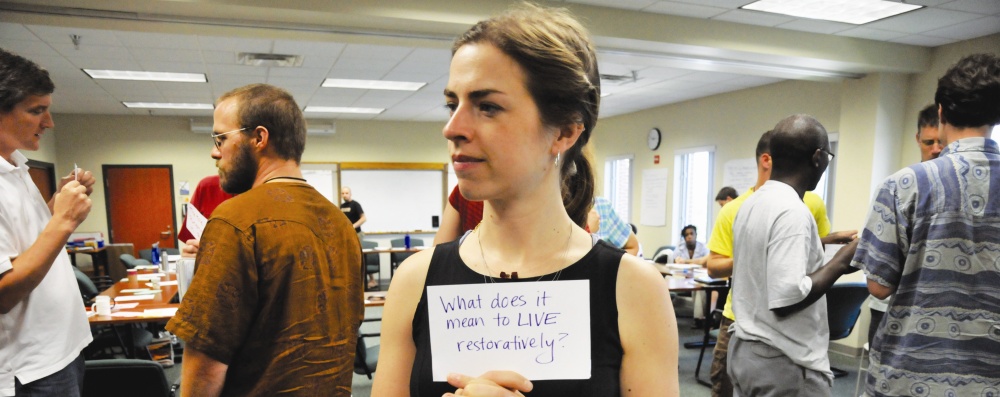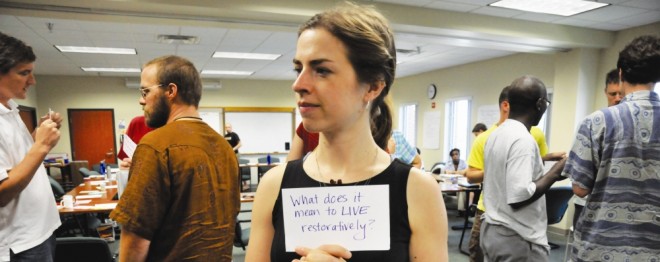Educating for peacebuilding

As school districts across North America – indeed perhaps across the world – struggle with how to enable students to study productively in safe, respectful school environments, more school personnel are checking into restorative justice and asking themselves whether the practices of “RJ” could be applied in their environments.
Certain school districts in Virginia, Michigan, Minnesota, Wisconsin, California and Colorado are among those leading the way in the United States in shifting to a restorative, community-based approach to handling conflicts within school systems.
One of the first “how to” books published in the United States was The Little Book of Restorative Discipline for Schools (Good Books, 2005), written by Lorraine Stutzman Amstutz, director of Mennonite Central Committee’s Office on Crime and Justice (and a frequent adjunct instructor at EMU), and EMU psychology professor Judy H. Mullet. The book was edited by EMU restorative justice professor Howard Zehr.
More recently, Catherine Bargen (MA ’08) has produced a fascinating, transparently honest summary of the steps taken and the lessons learned when she and other RJ experts worked to permeate the principles and practices of RJ through one of the largest school districts in Canada, School District #35 in Langley, British Columbia. Her book is titled Educating for Peacebuilding – Implementing restorative justice principles and practices in a school system (Fraser Region Community Justice Initiatives, 2010).
Below are 30 excerpts from the book. It is available for purchase from Fraser Region Community Justice Initiatives (CJI), a non-profit that has grown from seeds planted by the Langley Mennonite Fellowship Church in the 1980s. CJI works in all types of communities in British Columbia, including those within the criminal justice system. For more information, visit www.cjibc.org.

- Give careful thought to the terms you use and be intentional in how you use them… We decided upon “Restorative Action” [RA] after considering several alternatives. “Restorative Justice” seemed too closely associated with the criminal justice system. “Restorative Discipline,” while used by many respected colleagues, struck us as emphasizing wrong-doing and being associated with top-down decision-making… “Restorative Measures” sounded too legal. However, one of these terms may work for you. Just be sure to think through the message that you want to send. (p. 52)
- We avoid the terms “victim, offender,” or “bully,” as we don’t want to label students. Instead we say “kids,” or “students involved,” or “the guy that made the threat,” or simply “Ashley.” (p. 52)
- To make any progress, identify the senior administrators in the schools (principals and vice-principals) and at the school-district level who are interested in implementation. Not just “sounds like a neat idea” interested, but “I get this and I will do what it takes to get this into the school” interested. (p. 32)
- If you are committed to a certain school or district, start pitching the idea to school trustees, parents, and teachers until you have a critical mass of pressure. (p. 32)
- Seek out the teachers, students, and parents who are already interested and do not need much convincing. You will know who they are because they often respond to your pitch for restorative justice with comments such as: “This is what I already do intuitively! This makes so much sense! This should have been happening when I was a student!” …. These champions will form your core group of supporters and help your outreach work later. (p. 33)
- A model that has emerged and seems to work well involves designating one “point person” for each school. Anyone in the school community who is interested in any aspect of RA — including those who want to refer a situation — can approach this point person for assistance… For a point person to be effective, ongoing efforts must be made to ensure that he/ she is known, accessible, and up-to-date on the workings of the RA team. (p. 38)
- Even when schools are enthusiastic, they often experience initial difficulties and resistance to spending the necessary amount of time, energy, and resources on implementing RA. We try to frame it as “front-end loading” — an initial input of intense energy and focus, coupled with the hope that an RA team in the school will be a positive presence for change and lighten the load for everyone over time. See if you can find ways that make the initial training easier to support and understand for all involved. For example, students have given us feedback that it is useful for them to have a letter to show their teachers which explains the program and explains their absence from class in more depth. (p. 57)
- [From CJI’s 2003 annual report] Our team is realizing that implementing restorative peer mediation teams is not necessarily the primary measure of success or focus of the project. We are constantly reminded of our goal to help shift school culture, which can take many forms. In the elementary schools, many strategies are underway. We are involved in four elementary schools… Staff from each of these schools participated in a 16-hour training held from October to January… The aim of the elementary training was to “educate the educators” in RA and give them some basic skills for working with their students. This training was extremely well attended (32 staff from the four schools) and well received. (p. 20)
- [From CJI’s 2005 annual report] Although our programs and training methods are designed to be sustainable without our supervision and intervention, we are aware that many schools can use additional support and “troubleshooting” in implementing an effective RA program. (p. 22)
- [From CJI’s 2007 annual report] Dialogue circles — also known as peace circles — were initiated as a way for students to discuss important issues in a safe, non-judgmental atmosphere. Last May, two dialogue circles were held at Palm Elementary School with a group of 10 Grade 2 girls as a way to discuss the issue of inclusion on the playground. This was our first attempt at holding a dialogue circle and it was not only a lot of fun but a great educational tool to use with the girls. (p. 25)
- [From CJI’s 2008 annual report] Restorative dialogue circles were initiated at Victory Secondary School in spring 2007. Working with the school’s youth care worker, we facilitated four circles on the topic of drug and alcohol use and its effect on individuals as well as on the school community. Students responded positively and requested another series of circles. The next set of four circles was held in fall 2007. We had good initial response from students wanting to participate, with eight or nine students, mostly boys, consistently attending each session. The topic for this set of circles was on drugs and violence. More student-based requests led us to hold another set of four circles in spring 2008. (p. 27)
- [From CJI’s 2010 annual report] “At the elementary level, so far we have trained 10 students and one staff at Watson Elementary to be “Playground Pals.” This is the elementary equivalent of the secondary program, Conversation Peace. As a result of this initiative, these elementary students are now helping other students get along in the playground. (p. 31)
- In time we identified some effective strategic principles, the most important of which was: work with your allies. Others included: make it fun, make it accessible, involve students, and seek student input from the beginning of program development. We tried to make it about building relationships and helping schools see how what we’re offering helps them achieve their existing goals, mandated or otherwise. (p. 32)
- [Successful programs] empower young people by making sure they buy into the process willingly rather than feeling forced to participate in a face-to-face dialogue with someone they are in conflict with or have been hurt by. This is a real danger in school settings that have a culture that imposes top-down authority from adults, especially if they begin to unilaterally “enforce” RA. (p. 32)
- Sometimes RA programs become equated with “mediation programs,” which in turn are seen as being focused on problem-solving only. In this case progress may be made on a problem, but the underlying causes and accompanying bitter feelings remain. (p. 33)
- While it is possible to get started without any funding, it never hurts to have some. Sometimes a school district will make some money or in-kind support available, but not necessarily right away. Apply for grants that support youth initiatives, safe schools, and crime prevention and anti-violence initiatives. If you are part of the school administration, you may be able to creatively reallocate human and material resources. (p. 33)
- Once we had been running the RA program for five or six years, we received some financial support from the school district. We have also been fortunate to receive support from individual schools for matters such as providing relief teachers when classroom teachers were in the RA training. Other programs rely heavily on in-kind contributions — their rent, supplies, or even training materials are provided by other sources such as the school district or the local police detachment. Whatever the case, creativity and persistence are required. (p. 34)
- Getting small, one-time grants or funding is possible as many grants are available for supporting youth and anti-violence initiatives on a pilot-project basis. However, getting sustainable funding is often a life-long task. (p. 34)
- We quickly realized that schools found it difficult to schedule time for the training sessions, and so we adapted our schedule to fit theirs. Some chose to do it all at once — four days straight — while others opted for once a week or once every two weeks. Some schools were creative and did the training as a weekend retreat off-site. The key is to remain flexible with the training schedule or approach. (p. 35)
- We designed Conversation Peace so that according to the situation, adults and youth could train together or separately. Most of our training sessions have youth and adult participants together, an approach that everyone involved seems to enjoy. (p. 37)
- In some ways our model succeeded by simply creating a space where students could speak openly to each other to sort out problems, rather than having to relate in ways their friends might expect (e.g., showing bravado, making rude comments, intentionally shunning, and starting a fight). (p. 35)
- Pizza and doughnuts at lunch-time meetings are seen as a major perk and keep students involved and excited. I’m not sure if any research supports this, but it works. (p. 47)
- An enjoyable and successful part of this program involved including secondary-school student mediators in training as mentors for the elementary-level mediators. The secondary school students loved it and the elementary school ones were in awe. (p. 62, reworded slightly)
- In our RA program, we receive many referrals for interpersonal conflicts that result in classroom disruptions or complaints from parents. Others include: name calling, minor threats, email/internet misconduct, exclusion, minor harassment, and minor assaults and fighting. Many of these are successfully handled by the student mediators. We also take on more serious cases that include property damage and vandalism, persistent harassment and intimidation, plagiarism and systematic cheating on assignments, bringing small “weapons” (such as a pocket knife) to school, and cases of assault. In these situations we often use adult facilitators from CJI and/or trained school staff and district counsellors. (p. 38)
- After six years of implementing RA in SD35, we finally saw it become part of the district’s policy. The mandate to train an RA team in every secondary and elementary school first appeared in the Langley School Board’s 2006-2007 Strategic Plan and remains a part of their current plan. (p. 50)
- A Ministerial Order was released by provincial Ministry of Education in 2007 stating that Provincial Standards for Codes of Conduct require focusing on consequences “that are restorative in nature rather than punitive.” (p. 51)
- Explore how to make research and evaluation a priority from the outset. Programs similar to ours have conducted successful evaluation by engaging with a local university and creating a partnership that met their research needs while providing an exciting project for a grad student. (p. 58)
Long-time practitioner Dan Basham looked back at his four years of working on restorative action programs in British Columbia schools, and came up with a list of nine lessons. Here are three of them from Educating for Peacebuilding (pages 73 and 74):
- Work towards strengthening existing relationships before trying to forge new ones. Don’t neglect the individuals who have supported us. Keep them as priorities on a day-to-day basis.
- Be available. School staff members are working in a high-stress environment and are sometimes forced to multi-task as they handle serious situations. We should be available when they phone for help in order to avoid days of frustrating telephone tag. Being available helps create a trusting working relationship that can have a calming effect. If administrators know that help is at hand, they can take that one item off of their to-do list.
- Emphasize what Restorative Action (RA) is, as opposed to comparing it to punishment or what it is not. Some administrators and teachers fail to see that their school’s interventions amount to punishment. Then, when I compare RA to punishment it causes a defensive reaction, making it more of a hard sell and more difficult for them to understand. Some educators see RA as a challenge to their authority and are afraid that it will make them obsolete. Others feel that they are being criticized for how they are doing their job. No wonder they are not open to RA.
Reprinted from Educating for Peacebuilding. © Catherine Bargen. Used by permission. All rights reserved.
